Packaging Strategy 2: Initiatives for Solar Panel Logistics
VerifiedAdded on 2022/08/12
|11
|2433
|20
Report
AI Summary
This report provides a comprehensive analysis of packaging strategies for solar panel logistics. It explores various initiatives to improve efficiency, including palletization technology, CAD package design software, color technology, and product transportation methods. The report emphasizes the critical role of packaging in protecting fragile solar components, reducing costs, and ensuring timely delivery. It discusses how firms can optimize their packaging processes by integrating them into the product development stage, utilizing pallet software, and implementing Extended Color Gamut (ECG) printing for reduced waste. Furthermore, the report examines the impact of product stackability and adaptable transport units on transportation costs and efficiency, highlighting the importance of a well-coordinated approach to packaging and logistics. The report concludes by emphasizing the need for a logical approach to packaging initiatives and their impact on the solar industry's logistical systems, advocating for a focus on the relationship between packaging, tangible logistics, and cost variables to improve the overall effectiveness and efficiency of the packaging process.
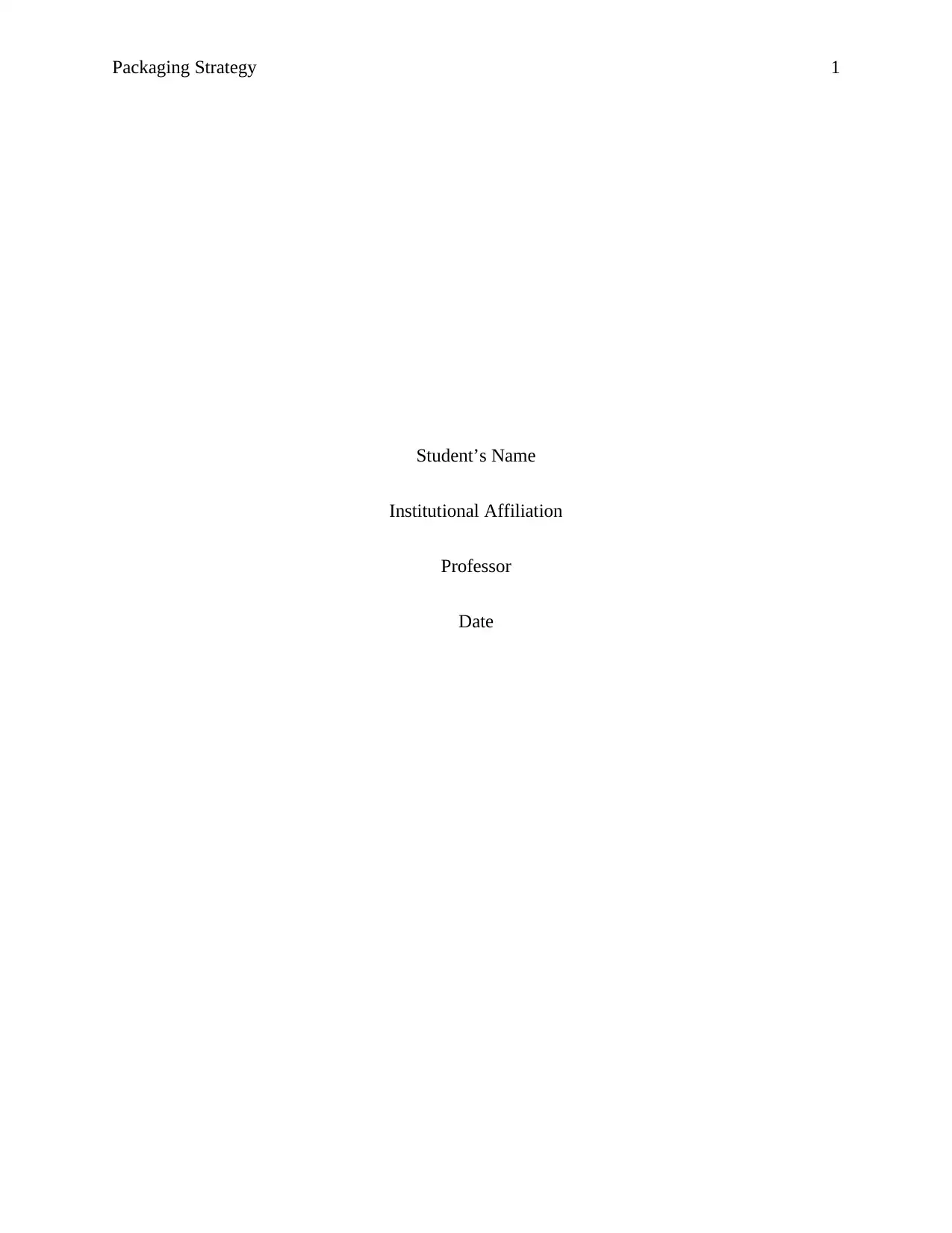
Packaging Strategy 1
Student’s Name
Institutional Affiliation
Professor
Date
Student’s Name
Institutional Affiliation
Professor
Date
Paraphrase This Document
Need a fresh take? Get an instant paraphrase of this document with our AI Paraphraser
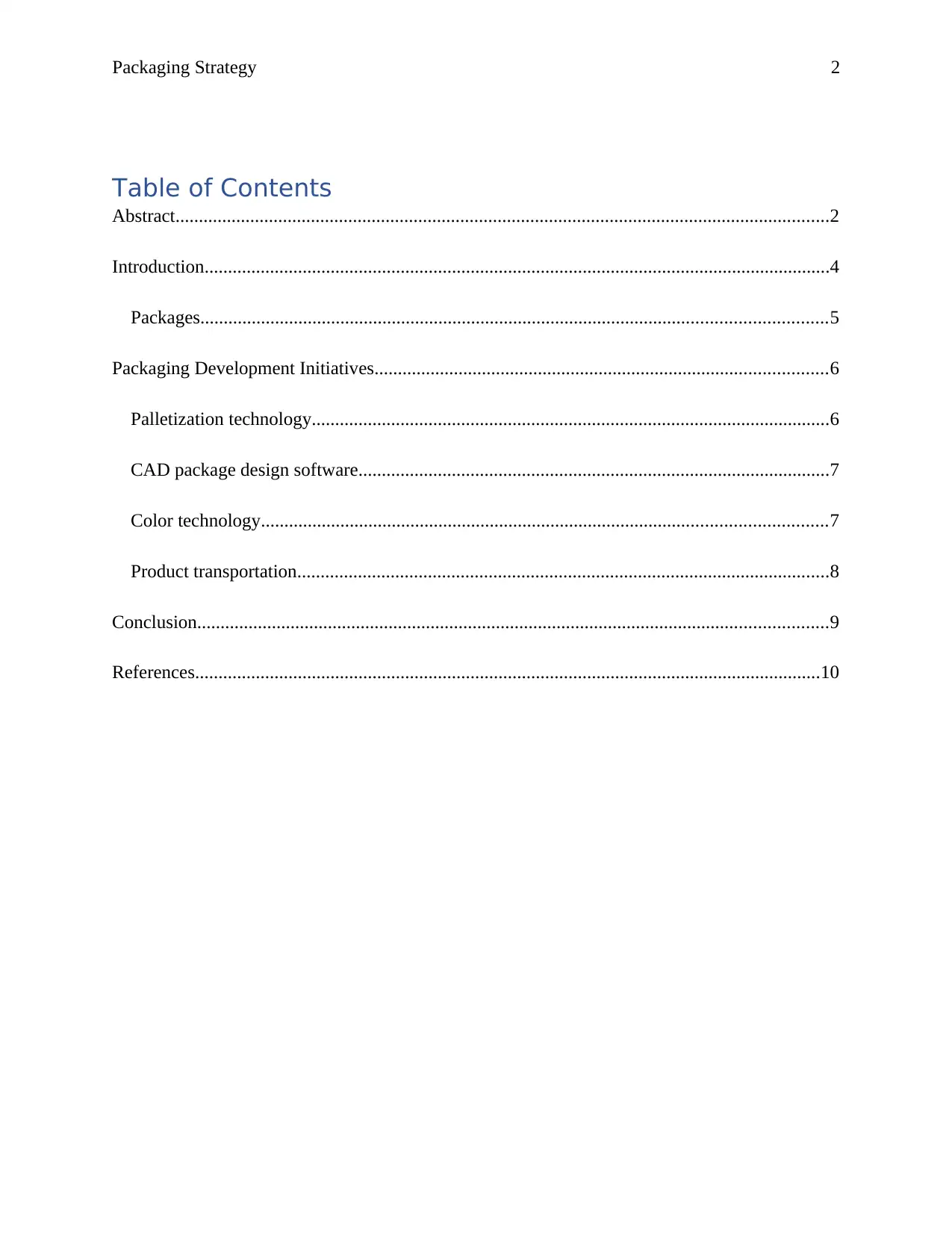
Packaging Strategy 2
Table of Contents
Abstract............................................................................................................................................2
Introduction......................................................................................................................................4
Packages......................................................................................................................................5
Packaging Development Initiatives.................................................................................................6
Palletization technology...............................................................................................................6
CAD package design software.....................................................................................................7
Color technology.........................................................................................................................7
Product transportation..................................................................................................................8
Conclusion.......................................................................................................................................9
References......................................................................................................................................10
Table of Contents
Abstract............................................................................................................................................2
Introduction......................................................................................................................................4
Packages......................................................................................................................................5
Packaging Development Initiatives.................................................................................................6
Palletization technology...............................................................................................................6
CAD package design software.....................................................................................................7
Color technology.........................................................................................................................7
Product transportation..................................................................................................................8
Conclusion.......................................................................................................................................9
References......................................................................................................................................10
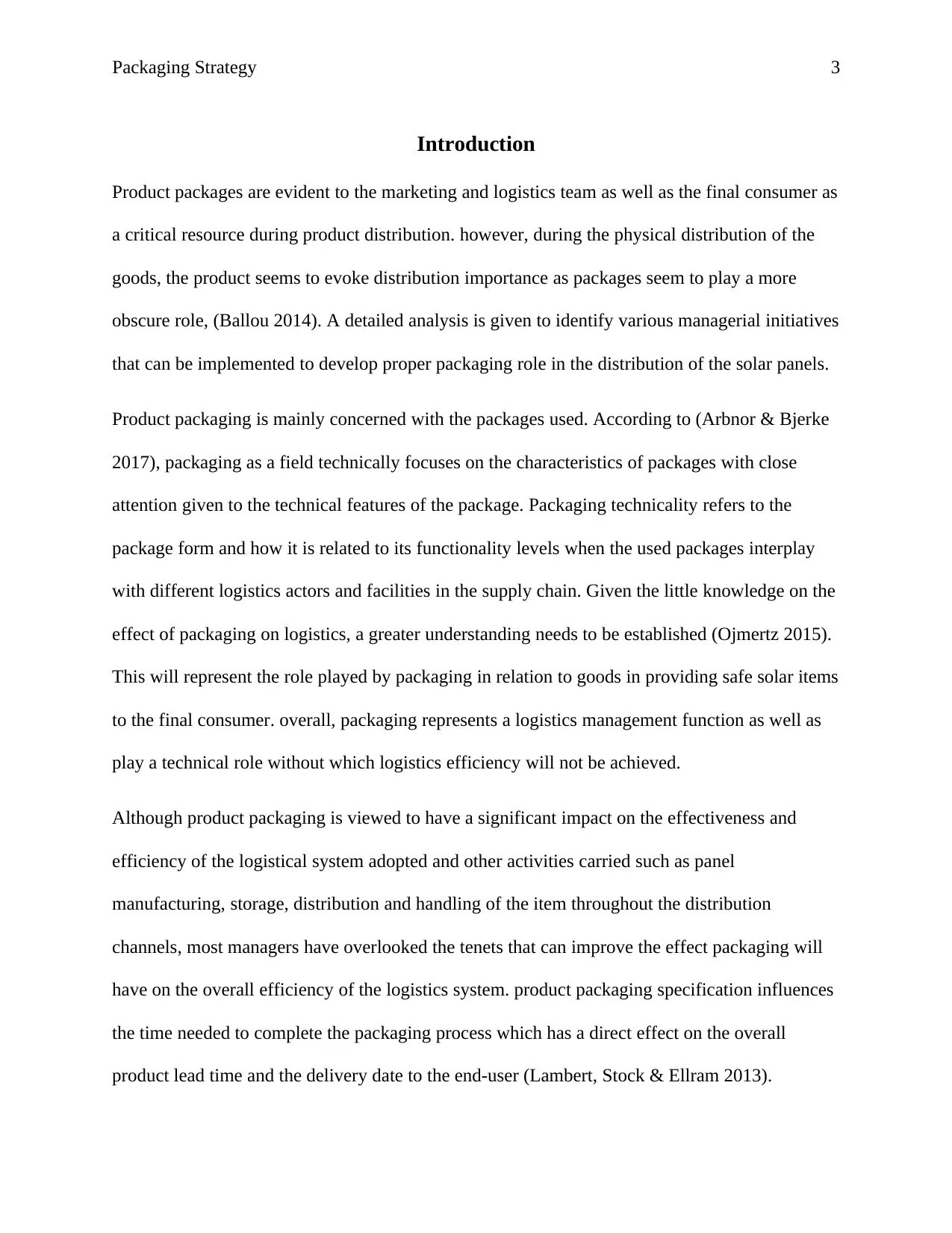
Packaging Strategy 3
Introduction
Product packages are evident to the marketing and logistics team as well as the final consumer as
a critical resource during product distribution. however, during the physical distribution of the
goods, the product seems to evoke distribution importance as packages seem to play a more
obscure role, (Ballou 2014). A detailed analysis is given to identify various managerial initiatives
that can be implemented to develop proper packaging role in the distribution of the solar panels.
Product packaging is mainly concerned with the packages used. According to (Arbnor & Bjerke
2017), packaging as a field technically focuses on the characteristics of packages with close
attention given to the technical features of the package. Packaging technicality refers to the
package form and how it is related to its functionality levels when the used packages interplay
with different logistics actors and facilities in the supply chain. Given the little knowledge on the
effect of packaging on logistics, a greater understanding needs to be established (Ojmertz 2015).
This will represent the role played by packaging in relation to goods in providing safe solar items
to the final consumer. overall, packaging represents a logistics management function as well as
play a technical role without which logistics efficiency will not be achieved.
Although product packaging is viewed to have a significant impact on the effectiveness and
efficiency of the logistical system adopted and other activities carried such as panel
manufacturing, storage, distribution and handling of the item throughout the distribution
channels, most managers have overlooked the tenets that can improve the effect packaging will
have on the overall efficiency of the logistics system. product packaging specification influences
the time needed to complete the packaging process which has a direct effect on the overall
product lead time and the delivery date to the end-user (Lambert, Stock & Ellram 2013).
Introduction
Product packages are evident to the marketing and logistics team as well as the final consumer as
a critical resource during product distribution. however, during the physical distribution of the
goods, the product seems to evoke distribution importance as packages seem to play a more
obscure role, (Ballou 2014). A detailed analysis is given to identify various managerial initiatives
that can be implemented to develop proper packaging role in the distribution of the solar panels.
Product packaging is mainly concerned with the packages used. According to (Arbnor & Bjerke
2017), packaging as a field technically focuses on the characteristics of packages with close
attention given to the technical features of the package. Packaging technicality refers to the
package form and how it is related to its functionality levels when the used packages interplay
with different logistics actors and facilities in the supply chain. Given the little knowledge on the
effect of packaging on logistics, a greater understanding needs to be established (Ojmertz 2015).
This will represent the role played by packaging in relation to goods in providing safe solar items
to the final consumer. overall, packaging represents a logistics management function as well as
play a technical role without which logistics efficiency will not be achieved.
Although product packaging is viewed to have a significant impact on the effectiveness and
efficiency of the logistical system adopted and other activities carried such as panel
manufacturing, storage, distribution and handling of the item throughout the distribution
channels, most managers have overlooked the tenets that can improve the effect packaging will
have on the overall efficiency of the logistics system. product packaging specification influences
the time needed to complete the packaging process which has a direct effect on the overall
product lead time and the delivery date to the end-user (Lambert, Stock & Ellram 2013).
⊘ This is a preview!⊘
Do you want full access?
Subscribe today to unlock all pages.

Trusted by 1+ million students worldwide
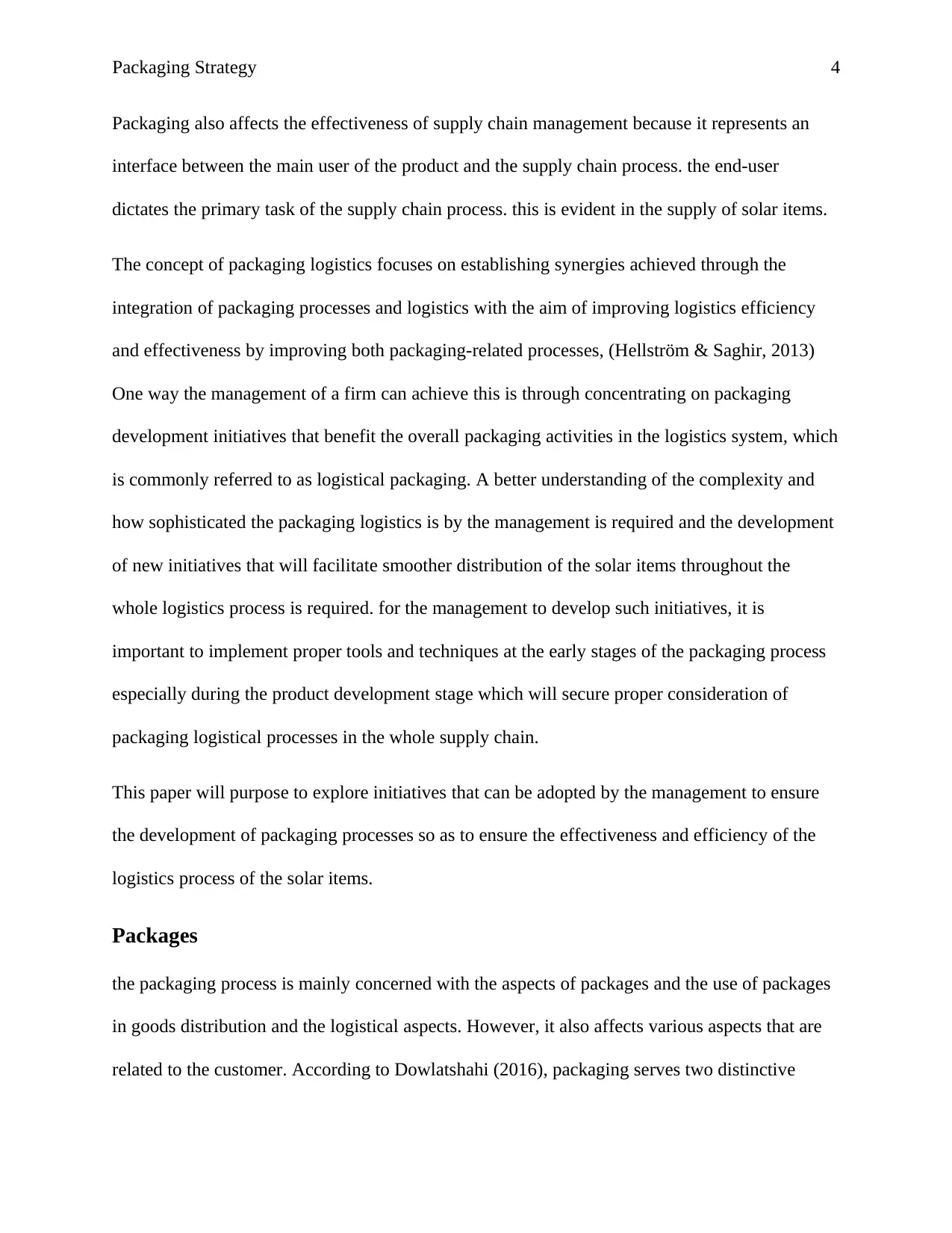
Packaging Strategy 4
Packaging also affects the effectiveness of supply chain management because it represents an
interface between the main user of the product and the supply chain process. the end-user
dictates the primary task of the supply chain process. this is evident in the supply of solar items.
The concept of packaging logistics focuses on establishing synergies achieved through the
integration of packaging processes and logistics with the aim of improving logistics efficiency
and effectiveness by improving both packaging-related processes, (Hellström & Saghir, 2013)
One way the management of a firm can achieve this is through concentrating on packaging
development initiatives that benefit the overall packaging activities in the logistics system, which
is commonly referred to as logistical packaging. A better understanding of the complexity and
how sophisticated the packaging logistics is by the management is required and the development
of new initiatives that will facilitate smoother distribution of the solar items throughout the
whole logistics process is required. for the management to develop such initiatives, it is
important to implement proper tools and techniques at the early stages of the packaging process
especially during the product development stage which will secure proper consideration of
packaging logistical processes in the whole supply chain.
This paper will purpose to explore initiatives that can be adopted by the management to ensure
the development of packaging processes so as to ensure the effectiveness and efficiency of the
logistics process of the solar items.
Packages
the packaging process is mainly concerned with the aspects of packages and the use of packages
in goods distribution and the logistical aspects. However, it also affects various aspects that are
related to the customer. According to Dowlatshahi (2016), packaging serves two distinctive
Packaging also affects the effectiveness of supply chain management because it represents an
interface between the main user of the product and the supply chain process. the end-user
dictates the primary task of the supply chain process. this is evident in the supply of solar items.
The concept of packaging logistics focuses on establishing synergies achieved through the
integration of packaging processes and logistics with the aim of improving logistics efficiency
and effectiveness by improving both packaging-related processes, (Hellström & Saghir, 2013)
One way the management of a firm can achieve this is through concentrating on packaging
development initiatives that benefit the overall packaging activities in the logistics system, which
is commonly referred to as logistical packaging. A better understanding of the complexity and
how sophisticated the packaging logistics is by the management is required and the development
of new initiatives that will facilitate smoother distribution of the solar items throughout the
whole logistics process is required. for the management to develop such initiatives, it is
important to implement proper tools and techniques at the early stages of the packaging process
especially during the product development stage which will secure proper consideration of
packaging logistical processes in the whole supply chain.
This paper will purpose to explore initiatives that can be adopted by the management to ensure
the development of packaging processes so as to ensure the effectiveness and efficiency of the
logistics process of the solar items.
Packages
the packaging process is mainly concerned with the aspects of packages and the use of packages
in goods distribution and the logistical aspects. However, it also affects various aspects that are
related to the customer. According to Dowlatshahi (2016), packaging serves two distinctive
Paraphrase This Document
Need a fresh take? Get an instant paraphrase of this document with our AI Paraphraser
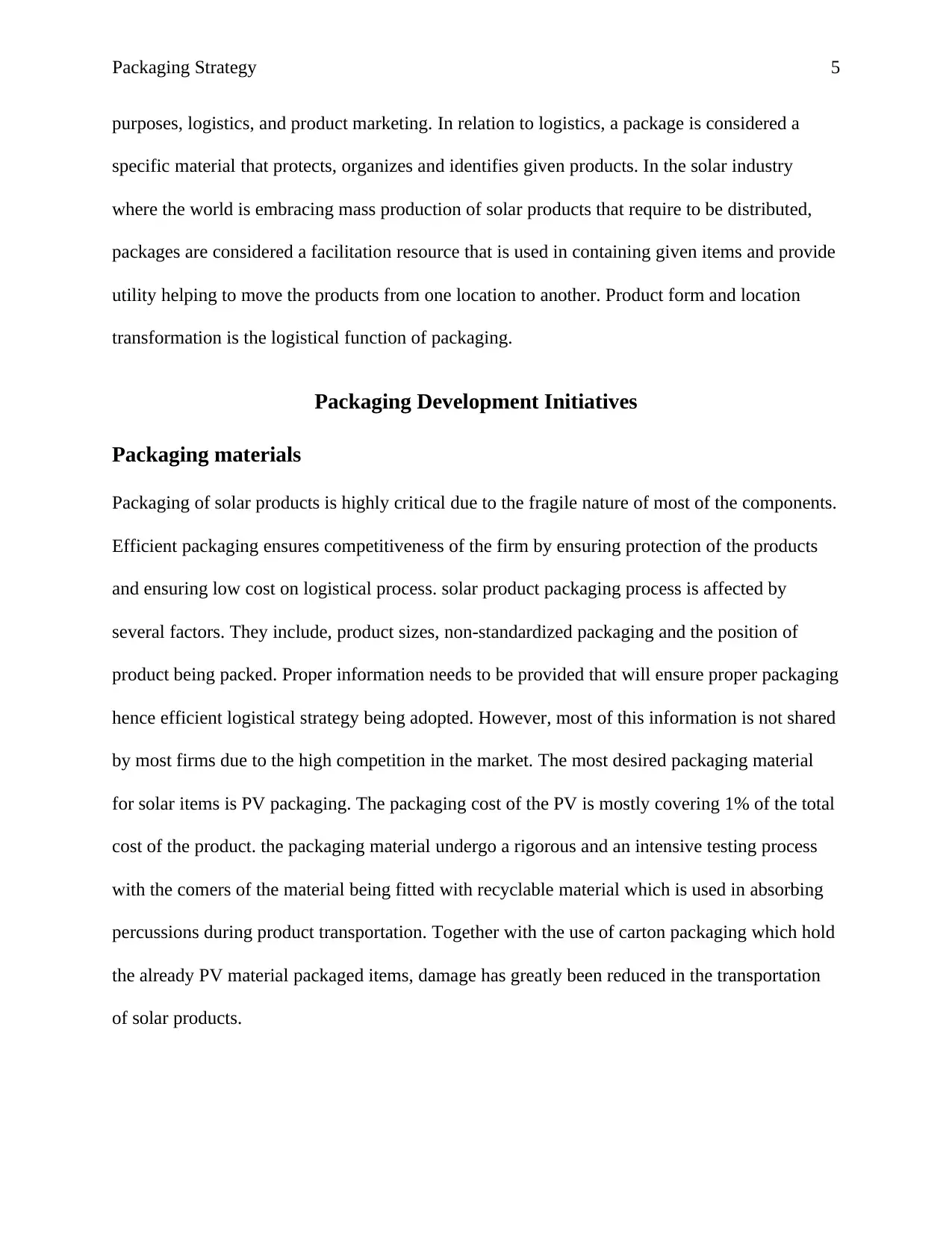
Packaging Strategy 5
purposes, logistics, and product marketing. In relation to logistics, a package is considered a
specific material that protects, organizes and identifies given products. In the solar industry
where the world is embracing mass production of solar products that require to be distributed,
packages are considered a facilitation resource that is used in containing given items and provide
utility helping to move the products from one location to another. Product form and location
transformation is the logistical function of packaging.
Packaging Development Initiatives
Packaging materials
Packaging of solar products is highly critical due to the fragile nature of most of the components.
Efficient packaging ensures competitiveness of the firm by ensuring protection of the products
and ensuring low cost on logistical process. solar product packaging process is affected by
several factors. They include, product sizes, non-standardized packaging and the position of
product being packed. Proper information needs to be provided that will ensure proper packaging
hence efficient logistical strategy being adopted. However, most of this information is not shared
by most firms due to the high competition in the market. The most desired packaging material
for solar items is PV packaging. The packaging cost of the PV is mostly covering 1% of the total
cost of the product. the packaging material undergo a rigorous and an intensive testing process
with the comers of the material being fitted with recyclable material which is used in absorbing
percussions during product transportation. Together with the use of carton packaging which hold
the already PV material packaged items, damage has greatly been reduced in the transportation
of solar products.
purposes, logistics, and product marketing. In relation to logistics, a package is considered a
specific material that protects, organizes and identifies given products. In the solar industry
where the world is embracing mass production of solar products that require to be distributed,
packages are considered a facilitation resource that is used in containing given items and provide
utility helping to move the products from one location to another. Product form and location
transformation is the logistical function of packaging.
Packaging Development Initiatives
Packaging materials
Packaging of solar products is highly critical due to the fragile nature of most of the components.
Efficient packaging ensures competitiveness of the firm by ensuring protection of the products
and ensuring low cost on logistical process. solar product packaging process is affected by
several factors. They include, product sizes, non-standardized packaging and the position of
product being packed. Proper information needs to be provided that will ensure proper packaging
hence efficient logistical strategy being adopted. However, most of this information is not shared
by most firms due to the high competition in the market. The most desired packaging material
for solar items is PV packaging. The packaging cost of the PV is mostly covering 1% of the total
cost of the product. the packaging material undergo a rigorous and an intensive testing process
with the comers of the material being fitted with recyclable material which is used in absorbing
percussions during product transportation. Together with the use of carton packaging which hold
the already PV material packaged items, damage has greatly been reduced in the transportation
of solar products.
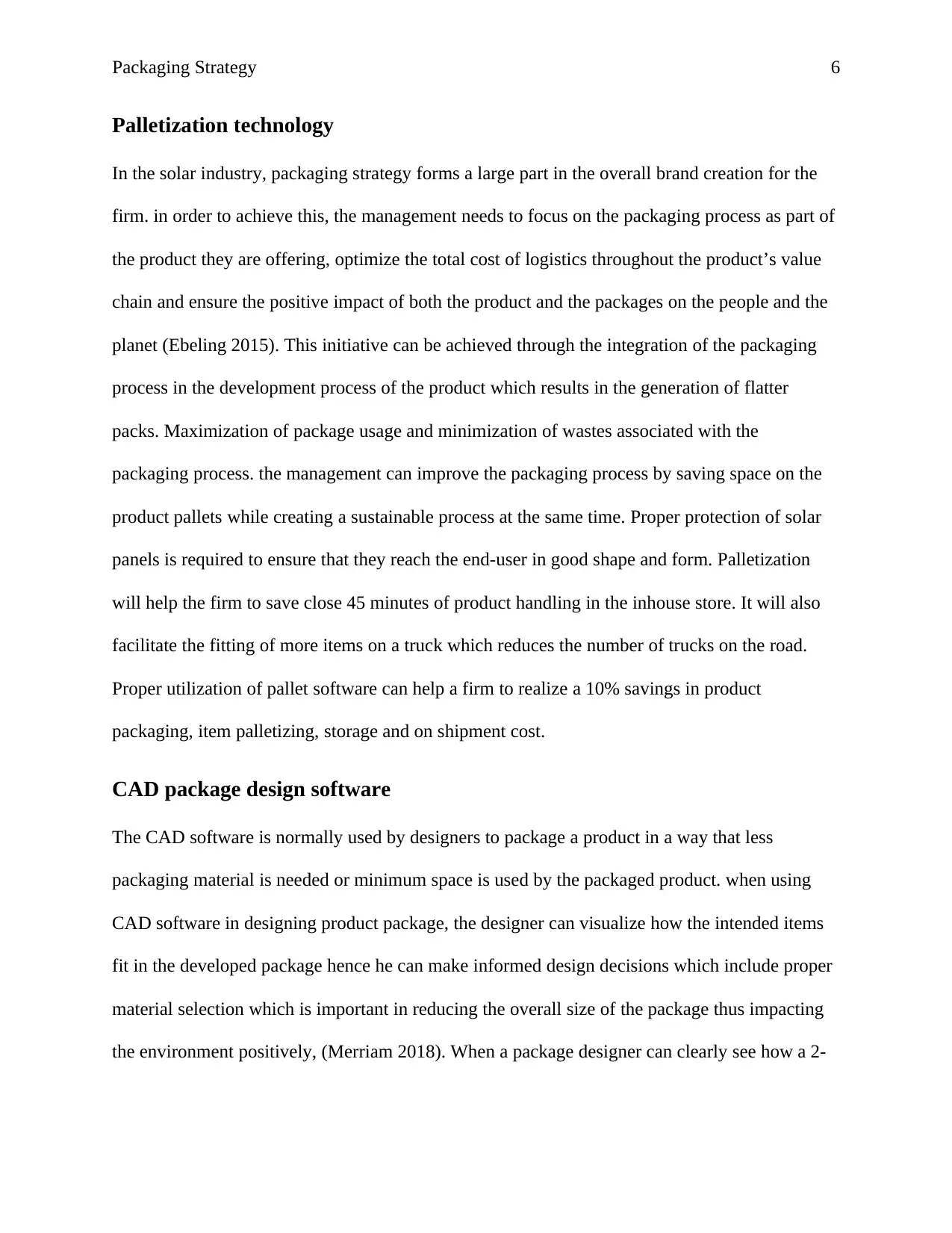
Packaging Strategy 6
Palletization technology
In the solar industry, packaging strategy forms a large part in the overall brand creation for the
firm. in order to achieve this, the management needs to focus on the packaging process as part of
the product they are offering, optimize the total cost of logistics throughout the product’s value
chain and ensure the positive impact of both the product and the packages on the people and the
planet (Ebeling 2015). This initiative can be achieved through the integration of the packaging
process in the development process of the product which results in the generation of flatter
packs. Maximization of package usage and minimization of wastes associated with the
packaging process. the management can improve the packaging process by saving space on the
product pallets while creating a sustainable process at the same time. Proper protection of solar
panels is required to ensure that they reach the end-user in good shape and form. Palletization
will help the firm to save close 45 minutes of product handling in the inhouse store. It will also
facilitate the fitting of more items on a truck which reduces the number of trucks on the road.
Proper utilization of pallet software can help a firm to realize a 10% savings in product
packaging, item palletizing, storage and on shipment cost.
CAD package design software
The CAD software is normally used by designers to package a product in a way that less
packaging material is needed or minimum space is used by the packaged product. when using
CAD software in designing product package, the designer can visualize how the intended items
fit in the developed package hence he can make informed design decisions which include proper
material selection which is important in reducing the overall size of the package thus impacting
the environment positively, (Merriam 2018). When a package designer can clearly see how a 2-
Palletization technology
In the solar industry, packaging strategy forms a large part in the overall brand creation for the
firm. in order to achieve this, the management needs to focus on the packaging process as part of
the product they are offering, optimize the total cost of logistics throughout the product’s value
chain and ensure the positive impact of both the product and the packages on the people and the
planet (Ebeling 2015). This initiative can be achieved through the integration of the packaging
process in the development process of the product which results in the generation of flatter
packs. Maximization of package usage and minimization of wastes associated with the
packaging process. the management can improve the packaging process by saving space on the
product pallets while creating a sustainable process at the same time. Proper protection of solar
panels is required to ensure that they reach the end-user in good shape and form. Palletization
will help the firm to save close 45 minutes of product handling in the inhouse store. It will also
facilitate the fitting of more items on a truck which reduces the number of trucks on the road.
Proper utilization of pallet software can help a firm to realize a 10% savings in product
packaging, item palletizing, storage and on shipment cost.
CAD package design software
The CAD software is normally used by designers to package a product in a way that less
packaging material is needed or minimum space is used by the packaged product. when using
CAD software in designing product package, the designer can visualize how the intended items
fit in the developed package hence he can make informed design decisions which include proper
material selection which is important in reducing the overall size of the package thus impacting
the environment positively, (Merriam 2018). When a package designer can clearly see how a 2-
⊘ This is a preview!⊘
Do you want full access?
Subscribe today to unlock all pages.

Trusted by 1+ million students worldwide
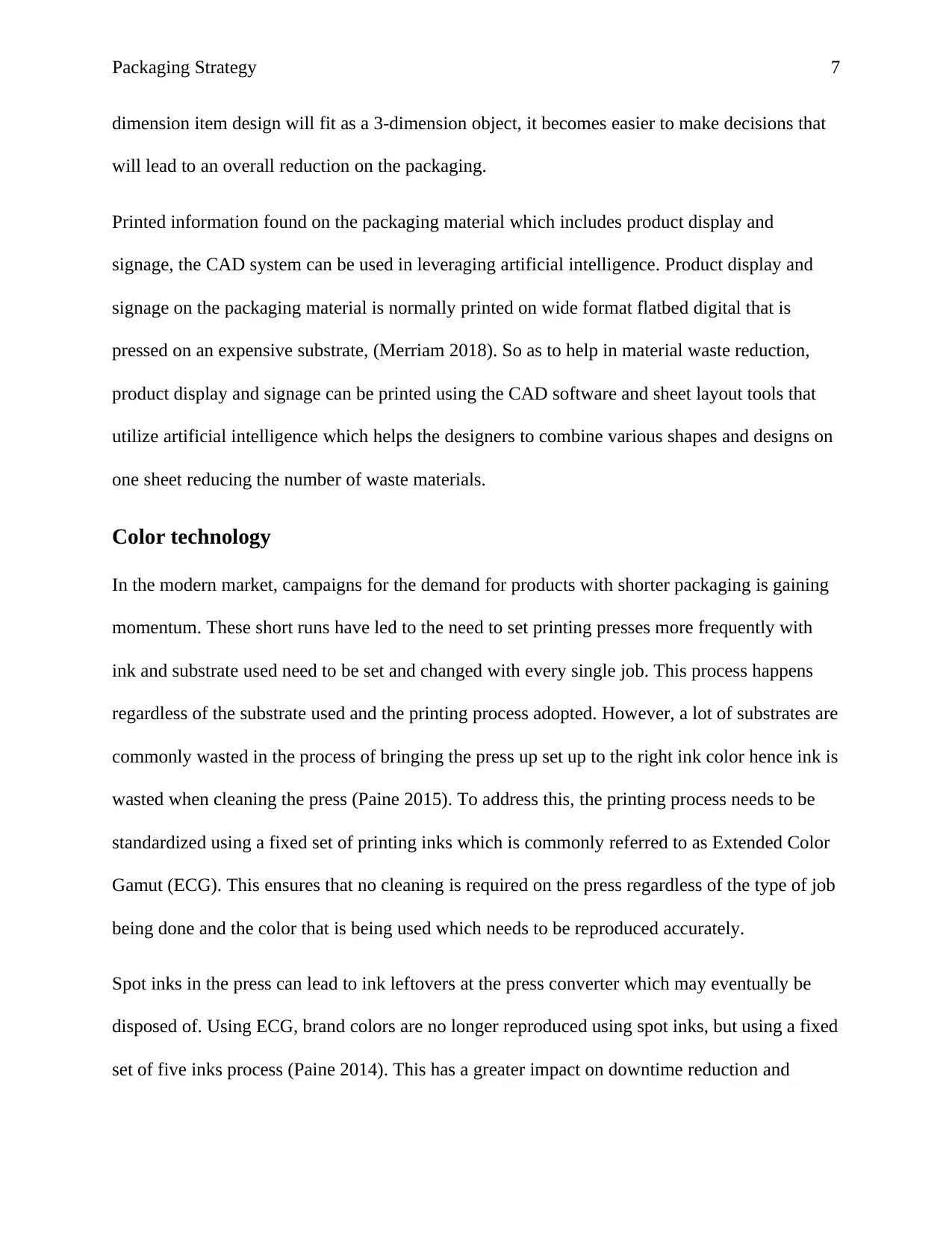
Packaging Strategy 7
dimension item design will fit as a 3-dimension object, it becomes easier to make decisions that
will lead to an overall reduction on the packaging.
Printed information found on the packaging material which includes product display and
signage, the CAD system can be used in leveraging artificial intelligence. Product display and
signage on the packaging material is normally printed on wide format flatbed digital that is
pressed on an expensive substrate, (Merriam 2018). So as to help in material waste reduction,
product display and signage can be printed using the CAD software and sheet layout tools that
utilize artificial intelligence which helps the designers to combine various shapes and designs on
one sheet reducing the number of waste materials.
Color technology
In the modern market, campaigns for the demand for products with shorter packaging is gaining
momentum. These short runs have led to the need to set printing presses more frequently with
ink and substrate used need to be set and changed with every single job. This process happens
regardless of the substrate used and the printing process adopted. However, a lot of substrates are
commonly wasted in the process of bringing the press up set up to the right ink color hence ink is
wasted when cleaning the press (Paine 2015). To address this, the printing process needs to be
standardized using a fixed set of printing inks which is commonly referred to as Extended Color
Gamut (ECG). This ensures that no cleaning is required on the press regardless of the type of job
being done and the color that is being used which needs to be reproduced accurately.
Spot inks in the press can lead to ink leftovers at the press converter which may eventually be
disposed of. Using ECG, brand colors are no longer reproduced using spot inks, but using a fixed
set of five inks process (Paine 2014). This has a greater impact on downtime reduction and
dimension item design will fit as a 3-dimension object, it becomes easier to make decisions that
will lead to an overall reduction on the packaging.
Printed information found on the packaging material which includes product display and
signage, the CAD system can be used in leveraging artificial intelligence. Product display and
signage on the packaging material is normally printed on wide format flatbed digital that is
pressed on an expensive substrate, (Merriam 2018). So as to help in material waste reduction,
product display and signage can be printed using the CAD software and sheet layout tools that
utilize artificial intelligence which helps the designers to combine various shapes and designs on
one sheet reducing the number of waste materials.
Color technology
In the modern market, campaigns for the demand for products with shorter packaging is gaining
momentum. These short runs have led to the need to set printing presses more frequently with
ink and substrate used need to be set and changed with every single job. This process happens
regardless of the substrate used and the printing process adopted. However, a lot of substrates are
commonly wasted in the process of bringing the press up set up to the right ink color hence ink is
wasted when cleaning the press (Paine 2015). To address this, the printing process needs to be
standardized using a fixed set of printing inks which is commonly referred to as Extended Color
Gamut (ECG). This ensures that no cleaning is required on the press regardless of the type of job
being done and the color that is being used which needs to be reproduced accurately.
Spot inks in the press can lead to ink leftovers at the press converter which may eventually be
disposed of. Using ECG, brand colors are no longer reproduced using spot inks, but using a fixed
set of five inks process (Paine 2014). This has a greater impact on downtime reduction and
Paraphrase This Document
Need a fresh take? Get an instant paraphrase of this document with our AI Paraphraser
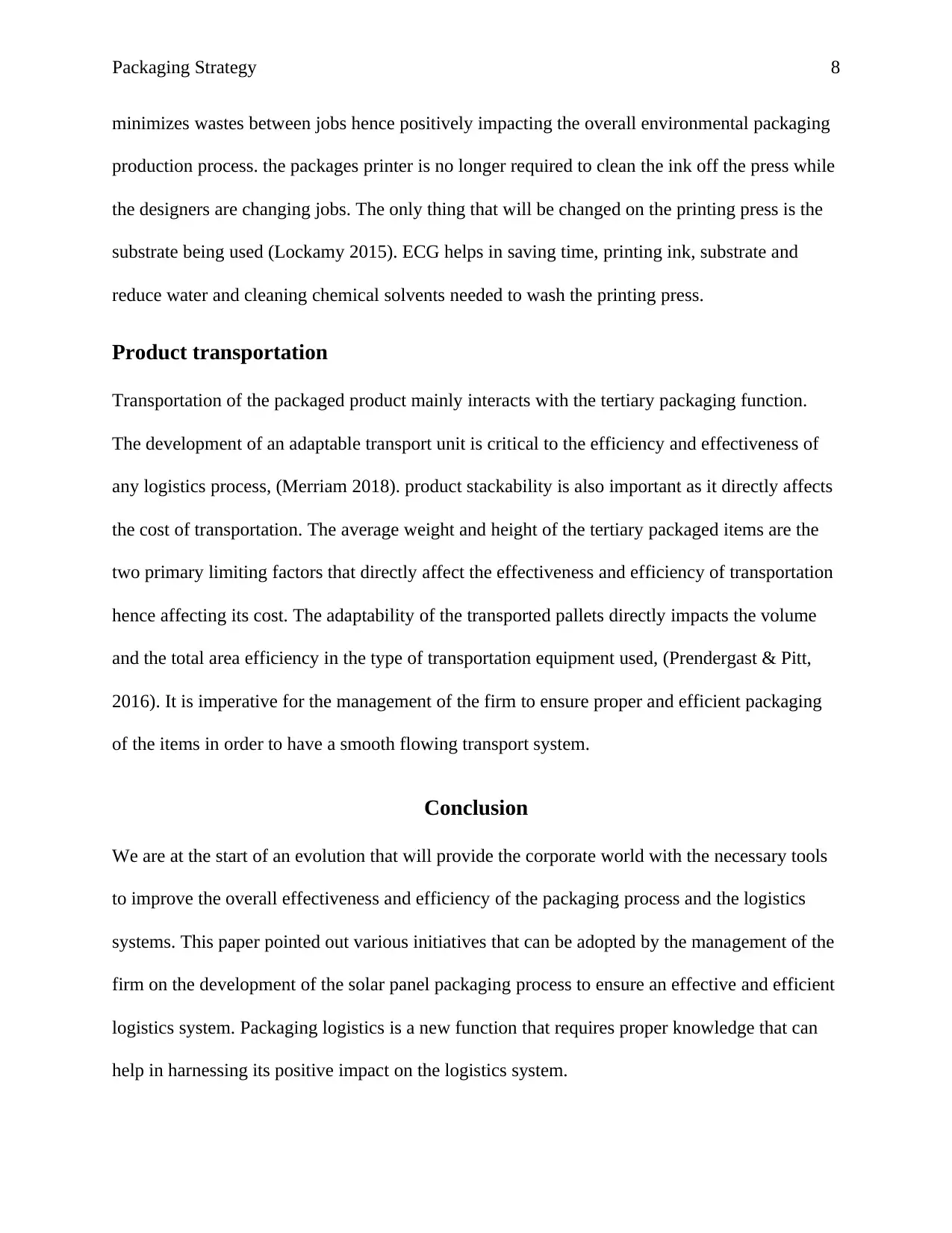
Packaging Strategy 8
minimizes wastes between jobs hence positively impacting the overall environmental packaging
production process. the packages printer is no longer required to clean the ink off the press while
the designers are changing jobs. The only thing that will be changed on the printing press is the
substrate being used (Lockamy 2015). ECG helps in saving time, printing ink, substrate and
reduce water and cleaning chemical solvents needed to wash the printing press.
Product transportation
Transportation of the packaged product mainly interacts with the tertiary packaging function.
The development of an adaptable transport unit is critical to the efficiency and effectiveness of
any logistics process, (Merriam 2018). product stackability is also important as it directly affects
the cost of transportation. The average weight and height of the tertiary packaged items are the
two primary limiting factors that directly affect the effectiveness and efficiency of transportation
hence affecting its cost. The adaptability of the transported pallets directly impacts the volume
and the total area efficiency in the type of transportation equipment used, (Prendergast & Pitt,
2016). It is imperative for the management of the firm to ensure proper and efficient packaging
of the items in order to have a smooth flowing transport system.
Conclusion
We are at the start of an evolution that will provide the corporate world with the necessary tools
to improve the overall effectiveness and efficiency of the packaging process and the logistics
systems. This paper pointed out various initiatives that can be adopted by the management of the
firm on the development of the solar panel packaging process to ensure an effective and efficient
logistics system. Packaging logistics is a new function that requires proper knowledge that can
help in harnessing its positive impact on the logistics system.
minimizes wastes between jobs hence positively impacting the overall environmental packaging
production process. the packages printer is no longer required to clean the ink off the press while
the designers are changing jobs. The only thing that will be changed on the printing press is the
substrate being used (Lockamy 2015). ECG helps in saving time, printing ink, substrate and
reduce water and cleaning chemical solvents needed to wash the printing press.
Product transportation
Transportation of the packaged product mainly interacts with the tertiary packaging function.
The development of an adaptable transport unit is critical to the efficiency and effectiveness of
any logistics process, (Merriam 2018). product stackability is also important as it directly affects
the cost of transportation. The average weight and height of the tertiary packaged items are the
two primary limiting factors that directly affect the effectiveness and efficiency of transportation
hence affecting its cost. The adaptability of the transported pallets directly impacts the volume
and the total area efficiency in the type of transportation equipment used, (Prendergast & Pitt,
2016). It is imperative for the management of the firm to ensure proper and efficient packaging
of the items in order to have a smooth flowing transport system.
Conclusion
We are at the start of an evolution that will provide the corporate world with the necessary tools
to improve the overall effectiveness and efficiency of the packaging process and the logistics
systems. This paper pointed out various initiatives that can be adopted by the management of the
firm on the development of the solar panel packaging process to ensure an effective and efficient
logistics system. Packaging logistics is a new function that requires proper knowledge that can
help in harnessing its positive impact on the logistics system.
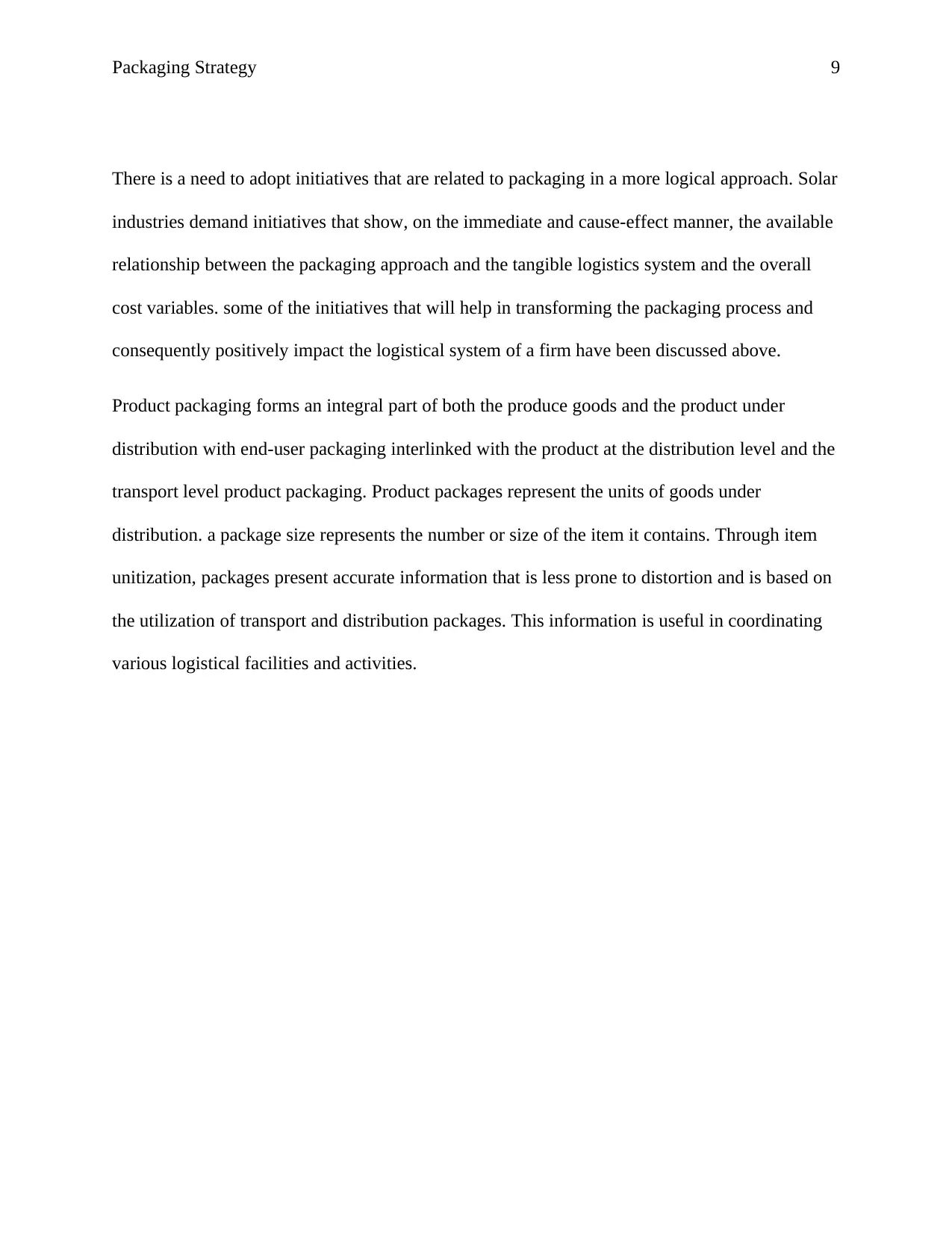
Packaging Strategy 9
There is a need to adopt initiatives that are related to packaging in a more logical approach. Solar
industries demand initiatives that show, on the immediate and cause-effect manner, the available
relationship between the packaging approach and the tangible logistics system and the overall
cost variables. some of the initiatives that will help in transforming the packaging process and
consequently positively impact the logistical system of a firm have been discussed above.
Product packaging forms an integral part of both the produce goods and the product under
distribution with end-user packaging interlinked with the product at the distribution level and the
transport level product packaging. Product packages represent the units of goods under
distribution. a package size represents the number or size of the item it contains. Through item
unitization, packages present accurate information that is less prone to distortion and is based on
the utilization of transport and distribution packages. This information is useful in coordinating
various logistical facilities and activities.
There is a need to adopt initiatives that are related to packaging in a more logical approach. Solar
industries demand initiatives that show, on the immediate and cause-effect manner, the available
relationship between the packaging approach and the tangible logistics system and the overall
cost variables. some of the initiatives that will help in transforming the packaging process and
consequently positively impact the logistical system of a firm have been discussed above.
Product packaging forms an integral part of both the produce goods and the product under
distribution with end-user packaging interlinked with the product at the distribution level and the
transport level product packaging. Product packages represent the units of goods under
distribution. a package size represents the number or size of the item it contains. Through item
unitization, packages present accurate information that is less prone to distortion and is based on
the utilization of transport and distribution packages. This information is useful in coordinating
various logistical facilities and activities.
⊘ This is a preview!⊘
Do you want full access?
Subscribe today to unlock all pages.

Trusted by 1+ million students worldwide
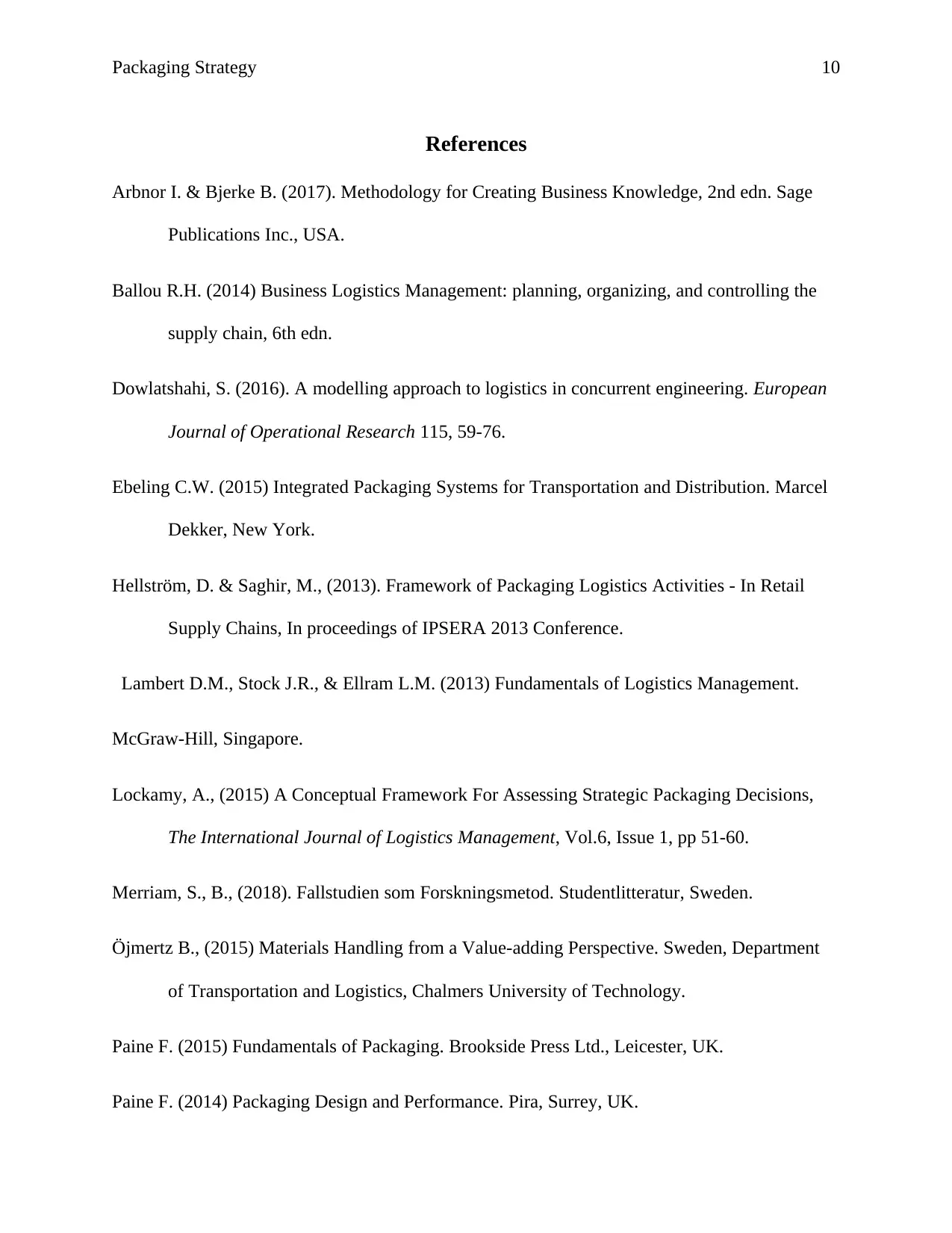
Packaging Strategy 10
References
Arbnor I. & Bjerke B. (2017). Methodology for Creating Business Knowledge, 2nd edn. Sage
Publications Inc., USA.
Ballou R.H. (2014) Business Logistics Management: planning, organizing, and controlling the
supply chain, 6th edn.
Dowlatshahi, S. (2016). A modelling approach to logistics in concurrent engineering. European
Journal of Operational Research 115, 59-76.
Ebeling C.W. (2015) Integrated Packaging Systems for Transportation and Distribution. Marcel
Dekker, New York.
Hellström, D. & Saghir, M., (2013). Framework of Packaging Logistics Activities - In Retail
Supply Chains, In proceedings of IPSERA 2013 Conference.
Lambert D.M., Stock J.R., & Ellram L.M. (2013) Fundamentals of Logistics Management.
McGraw-Hill, Singapore.
Lockamy, A., (2015) A Conceptual Framework For Assessing Strategic Packaging Decisions,
The International Journal of Logistics Management, Vol.6, Issue 1, pp 51-60.
Merriam, S., B., (2018). Fallstudien som Forskningsmetod. Studentlitteratur, Sweden.
Öjmertz B., (2015) Materials Handling from a Value-adding Perspective. Sweden, Department
of Transportation and Logistics, Chalmers University of Technology.
Paine F. (2015) Fundamentals of Packaging. Brookside Press Ltd., Leicester, UK.
Paine F. (2014) Packaging Design and Performance. Pira, Surrey, UK.
References
Arbnor I. & Bjerke B. (2017). Methodology for Creating Business Knowledge, 2nd edn. Sage
Publications Inc., USA.
Ballou R.H. (2014) Business Logistics Management: planning, organizing, and controlling the
supply chain, 6th edn.
Dowlatshahi, S. (2016). A modelling approach to logistics in concurrent engineering. European
Journal of Operational Research 115, 59-76.
Ebeling C.W. (2015) Integrated Packaging Systems for Transportation and Distribution. Marcel
Dekker, New York.
Hellström, D. & Saghir, M., (2013). Framework of Packaging Logistics Activities - In Retail
Supply Chains, In proceedings of IPSERA 2013 Conference.
Lambert D.M., Stock J.R., & Ellram L.M. (2013) Fundamentals of Logistics Management.
McGraw-Hill, Singapore.
Lockamy, A., (2015) A Conceptual Framework For Assessing Strategic Packaging Decisions,
The International Journal of Logistics Management, Vol.6, Issue 1, pp 51-60.
Merriam, S., B., (2018). Fallstudien som Forskningsmetod. Studentlitteratur, Sweden.
Öjmertz B., (2015) Materials Handling from a Value-adding Perspective. Sweden, Department
of Transportation and Logistics, Chalmers University of Technology.
Paine F. (2015) Fundamentals of Packaging. Brookside Press Ltd., Leicester, UK.
Paine F. (2014) Packaging Design and Performance. Pira, Surrey, UK.
Paraphrase This Document
Need a fresh take? Get an instant paraphrase of this document with our AI Paraphraser
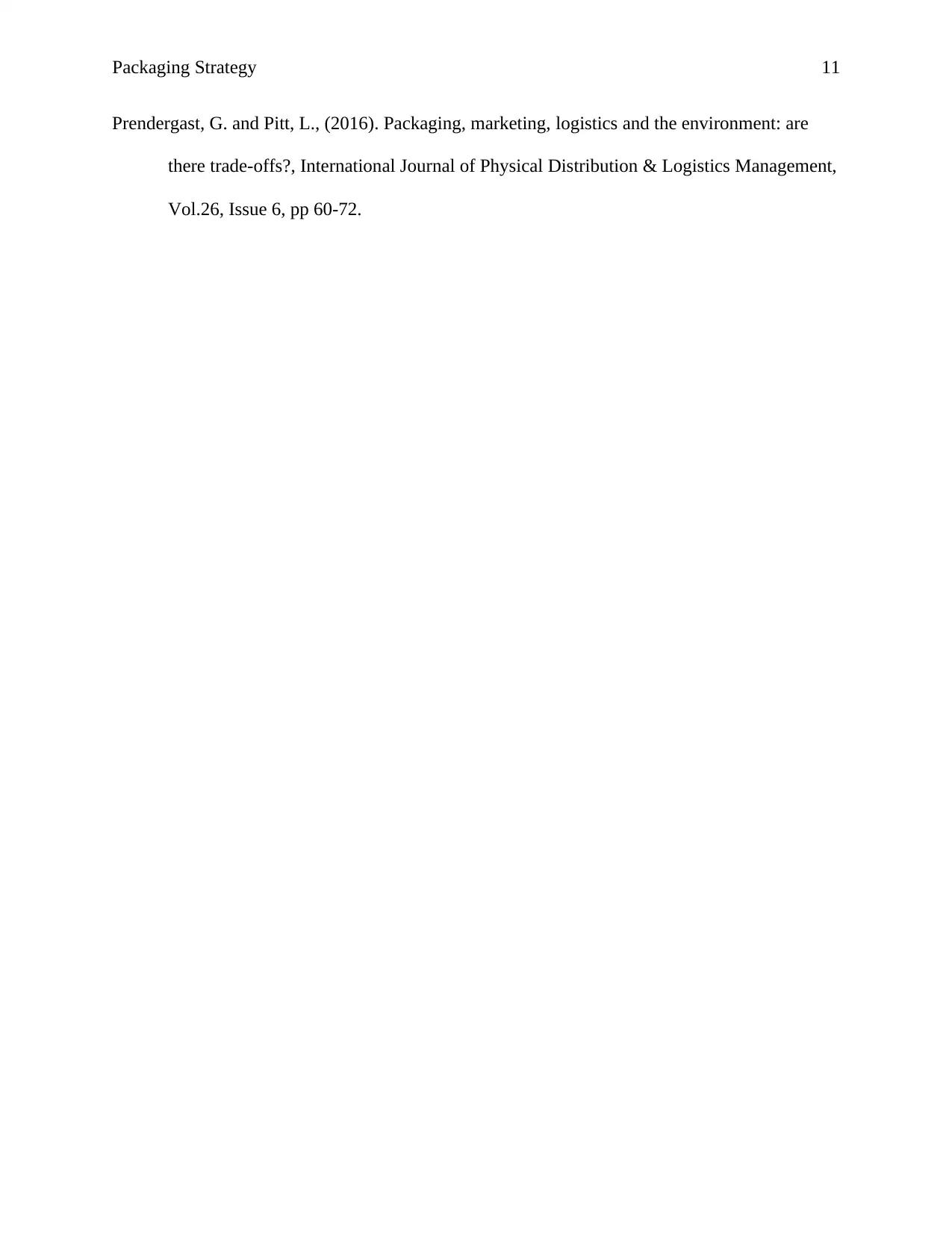
Packaging Strategy 11
Prendergast, G. and Pitt, L., (2016). Packaging, marketing, logistics and the environment: are
there trade-offs?, International Journal of Physical Distribution & Logistics Management,
Vol.26, Issue 6, pp 60-72.
Prendergast, G. and Pitt, L., (2016). Packaging, marketing, logistics and the environment: are
there trade-offs?, International Journal of Physical Distribution & Logistics Management,
Vol.26, Issue 6, pp 60-72.
1 out of 11
Related Documents
Your All-in-One AI-Powered Toolkit for Academic Success.
+13062052269
info@desklib.com
Available 24*7 on WhatsApp / Email
![[object Object]](/_next/static/media/star-bottom.7253800d.svg)
Unlock your academic potential
Copyright © 2020–2025 A2Z Services. All Rights Reserved. Developed and managed by ZUCOL.




